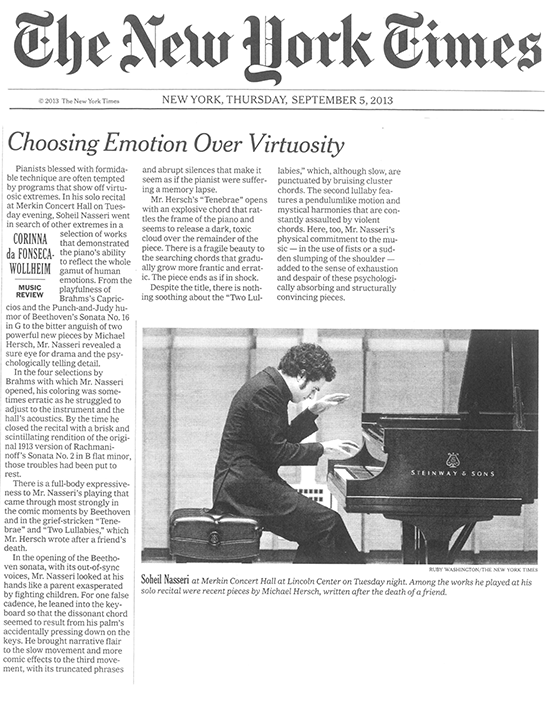Choosing Emotion Over Virtuosity
Corinna da Fonseca-Wollheim, The New York Times:
Pianists blessed with formidable technique are often tempted by programs that show off virtuosic extremes. In his solo recital at Merkin Concert Hall on Tuesday evening, Soheil Nasseri went in search of other extremes in a selection of works that demonstrated the piano’s ability to reflect the whole gamut of human emotions. From the playfulness of Brahms’s Capriccios and the Punch-and-Judy humor of Beethoven’s Sonata No. 16 in G to the bitter anguish of two powerful new pieces by Michael Hersch, Mr. Nasseri revealed a sure eye for drama and the psychologically telling detail.
In the four selections by Brahms with which Mr. Nasseri opened, his coloring was sometimes erratic as he struggled to adjust to the instrument and the hall’s acoustics. By the time he closed the recital with a brisk and scintillating rendition of the original 1913 version of Rachmaninoff’s Sonata No. 2 in B flat minor, those troubles had been put to rest.
There is a full-body expressiveness to Mr. Nasseri’s playing that came through most strongly in the comic moments by Beethoven and in the grief-stricken “Tenebrae” and “Two Lullabies,” which Mr. Hersch wrote after a friend’s death.
In the opening of the Beethoven sonata, with its out-of-sync voices, Mr. Nasseri looked at his hands like a parent exasperated by fighting children. For one false cadence, he leaned into the keyboard so that the dissonant chord seemed to result from his palm’s accidentally pressing down on the keys. He brought narrative flair to the slow movement and more comic effects to the third movement, with its truncated phrases and abrupt silences that make it seem as if the pianist were suffering a memory lapse.
Mr. Hersch’s “Tenebrae” opens with an explosive chord that rattles the frame of the piano and seems to release a dark, toxic cloud over the remainder of the piece. There is a fragile beauty to the searching chords that gradually grow more frantic and erratic. The piece ends as if in shock.
Despite the title, there is nothing soothing about the “Two Lullabies,” which, although slow, are punctuated by bruising cluster chords. The second lullaby features a pendulumlike motion and mystical harmonies that are constantly assaulted by violent chords. Here, too, Mr. Nasseri’s physical commitment to the music — in the use of fists or a sudden slumping of the shoulder — added to the sense of exhaustion and despair of these psychologically absorbing and structurally convincing pieces.



